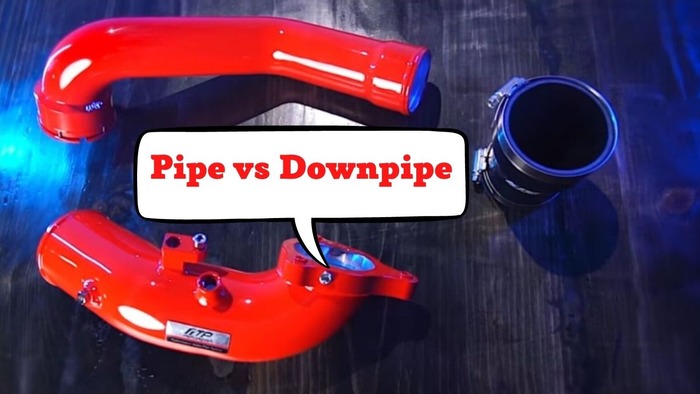
There are many benefits of a turbocharged or simply turbo engine. One is that it outputs more power owing to its intake of air. The increased power allows you to enjoy a more efficient and faster ride. Additionally, a turbo engine is smaller and lighter than the one that generates the same amount of power without a turbo.
But, for now, we won’t take this discussion further. We'll talk about two components of a turbo engine that many of us get confused about. That is, what’s the difference between a charge pipe and a downpipe in terms of functions? If this is what you’re looking for, then we’ve got you covered.
Charge Pipe vs Downpipe
We have already mentioned that a charge pipe and downpipe are essential components of a turbocharged engine. Both play a critical role in ensuring that your vehicle’s engine operates smoothly and with maximum efficiency. However, each has its unique role to play. So, what are these roles? How do they enhance the engine efficiency?
What is a Charge Pipe?
A charge pipe is a mandrel-bent tube connected to a vehicle’s intercooler piping and its intake manifold. This tube can be aluminum, stainless steel, or rubber material. Ideally, air flows from the turbocharger to the intercooler of an automotive engine. Next, it flows to the charge pipe and eventually to the engine via the intake valve. Thus, the charge pipe carries the turbo-charged air to the engine. It’s connected to either the Diverter Valve (DV) or the Blow-Off Valve (BOV).
What are the Functions of a Charge pipe?
While you’re driving your vehicle, the engine gets hot. Generally, the heat is harmful to a turbocharged engine. Therefore, there has to be a way to combat it to ensure that the car achieves maximum efficiency. First, the engine utilizes an intercooler that cools down the hot turbo air before recirculating it to the engine.
The charge pipe is attached to the intercooler. Thus, the air or gasses flow from the turbocharger to the intercooler. Then, the air flows to the charge pipe and ultimately to the engine through the intake valve. That means the charge pipe channels or carries the turbo-charged air to the car engine.
A charge pipe enhances the engine’s performance by cutting down the pressure loss of the turbocharged air. What’s more, the charge pipe boosts the airflow considerably from the turbo into the intercooler. The charge pipe transports the pressurized gasses from the turbo to the intake manifold. It helps direct the air, which leads to more power production with a small throttle opening. The pipe helps connect the turbo to the intake system of an engine.
Factory-Installed Charge Pipes
As mentioned, charge pipes are available in stainless steel, aluminum, or rubber materials. However, OEM pipes are plastic. Generally, plastic is lighter than metal. That means plastic charge pipes are cheaper and simpler to install. On the other hand, any metal is predisposed to corrosion. So, plastic charge pipes don’t corrode, which reduces a vehicle’s maintenance issues.
But still, plastic isn’t durable, and when it heats up, it can melt or take long to cool. That can limit the ability of the engine to achieve optimum efficiency. That means factory-installed or stock charge pipe won’t last long enough, and it’s likely to restrict the smooth flow of turbo-charged gasses.
Should I Install Aftermarket Charge Pipes?
Factory-installed charge pipes can blow out with time. However, this isn’t always the case. Some car owners choose to upgrade to keep the charge pipe from blowing out. Others wait for their original charge pipes to blow out and then upgrade.
But unlike stock charge pipes, aftermarket charge pipes (although maybe prone to corrosion) are more durable and reliable. They reduce the loss of turbo-charged air pressure and increase the airflow significantly from the turbocharger to the intercooler. This improves the performance of the engine. Hence, you can enhance your turbo-charged engine’s performance and reliability by using an aftermarket charge pipe.
How much horsepower can a charge pipe add? Well, note that this depends on whether or not the engine’s boost was leaking. If the stock pipe was faulty and the car had a leaking boost, then changing it will surely add power to your car. This will help you enjoy a more comfortable and smoother driving experience. However, if the factory-installed charge pipe wasn’t leaking, then the new charge pipe won’t add any power.
What is a Downpipe?

A downpipe is a section of tubing that directs the exhaust air from a car’s turbine housing to its exhaust system. In other words, a downpipe is connected to the turbine housing of a turbocharger to allow exhaust gasses to get out of the engine. Typically, downpipes come with restrictive catalytic converters. These catalytic converters play a significant role in cleaning exhaust air or gasses as the engine produces them. Thus, they minimize the emission of damaging gasses such as carbon monoxide, nitrogen oxide, etc.
What are the Functions of a Downpipe?
A downpipe allows a smooth exit of spent exhaust air from the engine. It also increases the efficiency of the engine’s turbo aspect. The downpipe directs gasses out of the turbine to enhance power. Usually, an aftermarket downpipe comes with a wider diameter. It’s less restrictive compared to a stock downpipe. The increased diameter offers a bigger space to allow a speedier turbo spin. That not only lowers turbo lag but also produces more spool. So, when you upgrade to an aftermarket downpipe, you reduce engine temperature and intake charge. In turn, this increases the engine’s power and enhances the overall comfort and driving experience.
Why Replace your Stock Downpipe?
If you have a sophisticated, supercharged car and you want to test its limit; you should upgrade its original downpipe. Remember that an aftermarket one increases the engine’s power and efficiency. You might also want to replace the catalytic converter with a more efficient (high-flowing) one.
A high-end car shouldn’t be timid. In that case, replacing your stock downpipe makes sense. As mentioned, you may also opt to replace it to enable your vehicle to give out more horsepower. How much horsepower does a downpipe add? Now, installing a downpipe to your turbo engine can increase power by 10 to 20 horsepower. This amount isn't negligible like some of us may think. Indeed, you’ll notice a significant difference anytime you engage the turbo.
Moreover, you may want to upgrade your downpipe after modifying your turbo to allow it to run at an increased boost pressure. An aftermarket downpipe can also make your car louder. That's because larger pipes allow more exhaust inside, causing a louder turbo.
Catted vs Catless Downpipes
Generally, there are two types of downpipes to consider if you decide to purchase an aftermarket downpipe for your car. These are catted and catless downpipes. What is the difference?
A catted downpipe includes a catalytic converter. Conversely, a catless downpipe doesn’t have the converter. The catalytic converter cleans exhaust gasses while they pass through it. This process helps to reduce the bad smell that comes with the raw exhaust air. Additionally, a catalytic converter is an eco-friendly device. It ensures that your car doesn’t emit large volumes of harmful gases like carbon monoxide.
Your car will exhaust gasses with harmful substances if it has a catless downpipe. That will also mean that your vehicle is producing a noticeable odor. Choosing a catted downpipe will be a wise move if you don’t want that to happen.
However, there are circumstances when you may want to go with a catless downpipe. One of them is when you want your car to be quieter while not moving. What’s more, a more silent vehicle means that you’ll be enjoying calmer rides around your neighborhood. Catless downpipes are more durable. The unavailability of a catalytic converter eliminates the problem of clogging up with oil and carbon deposits from the engine.
But if you don't want to cause a lot of harm to the environment you should choose a catted downpipe. You should also know that both catted and catless downpipes can add between 10 to 20 HP.
Final Thought
Undoubtedly, a charge pipe and downpipe are two different critical components of a turbo application. The former is a mandrel-bent tube connected to a car’s intercooler and intake manifold. It transports the turbo-charged air to the engine. On the other hand, a downpipe is tubing that connects the turbocharger's exhaust side with the car’s exhaust system. Ideally, it helps exit exhaust gasses from the engine. However, both have one thing in common. They help increase the engine’s power and the overall efficiency of a car. But, only the aftermarket components will enable your vehicle to achieve optimum performance. When looking for an aftermarket downpipe, you’ll have to choose between catted and catless options. That will depend on your needs and preferences like improving your vehicle performance, lowering noise pollution, etc.
About the authors
The CarAraC research team is composed of seasoned auto mechanics and automotive industry professionals, including individuals with advanced degrees and certifications in their field. Our team members boast prestigious credentials, reflecting their extensive knowledge and skills. These qualifications include: IMI: Institute of the Motor Industry, ASE-Certified Master Automobile Technicians; Coventry University, Graduate of MA in Automotive Journalism; Politecnico di Torino, Italy, MS Automotive Engineering; Ss. Cyril and Methodius University in Skopje, Mechanical University in Skopje; TOC Automotive College; DHA Suffa University, Department of Mechanical Engineering






Add comment